Kanthashree Mysore Sathyendra
Robust Acoustic and Semantic Contextual Biasing in Neural Transducers for Speech Recognition
May 09, 2023Abstract:Attention-based contextual biasing approaches have shown significant improvements in the recognition of generic and/or personal rare-words in End-to-End Automatic Speech Recognition (E2E ASR) systems like neural transducers. These approaches employ cross-attention to bias the model towards specific contextual entities injected as bias-phrases to the model. Prior approaches typically relied on subword encoders for encoding the bias phrases. However, subword tokenizations are coarse and fail to capture granular pronunciation information which is crucial for biasing based on acoustic similarity. In this work, we propose to use lightweight character representations to encode fine-grained pronunciation features to improve contextual biasing guided by acoustic similarity between the audio and the contextual entities (termed acoustic biasing). We further integrate pretrained neural language model (NLM) based encoders to encode the utterance's semantic context along with contextual entities to perform biasing informed by the utterance's semantic context (termed semantic biasing). Experiments using a Conformer Transducer model on the Librispeech dataset show a 4.62% - 9.26% relative WER improvement on different biasing list sizes over the baseline contextual model when incorporating our proposed acoustic and semantic biasing approach. On a large-scale in-house dataset, we observe 7.91% relative WER improvement compared to our baseline model. On tail utterances, the improvements are even more pronounced with 36.80% and 23.40% relative WER improvements on Librispeech rare words and an in-house testset respectively.
Dialog act guided contextual adapter for personalized speech recognition
Mar 31, 2023
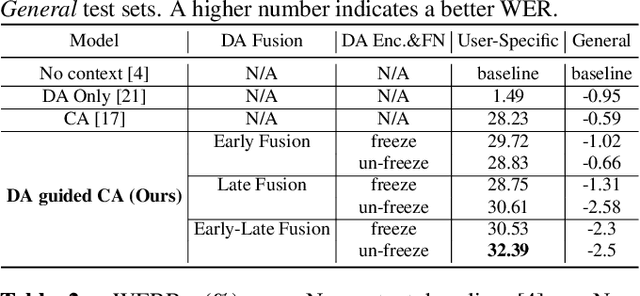
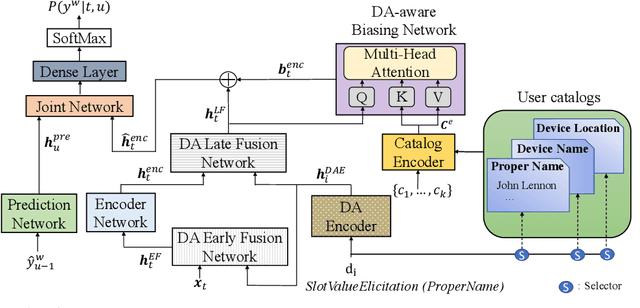
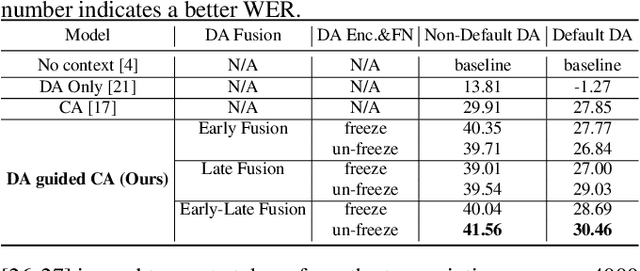
Abstract:Personalization in multi-turn dialogs has been a long standing challenge for end-to-end automatic speech recognition (E2E ASR) models. Recent work on contextual adapters has tackled rare word recognition using user catalogs. This adaptation, however, does not incorporate an important cue, the dialog act, which is available in a multi-turn dialog scenario. In this work, we propose a dialog act guided contextual adapter network. Specifically, it leverages dialog acts to select the most relevant user catalogs and creates queries based on both -- the audio as well as the semantic relationship between the carrier phrase and user catalogs to better guide the contextual biasing. On industrial voice assistant datasets, our model outperforms both the baselines - dialog act encoder-only model, and the contextual adaptation, leading to the most improvement over the no-context model: 58% average relative word error rate reduction (WERR) in the multi-turn dialog scenario, in comparison to the prior-art contextual adapter, which has achieved 39% WERR over the no-context model.
Contextual Adapters for Personalized Speech Recognition in Neural Transducers
May 26, 2022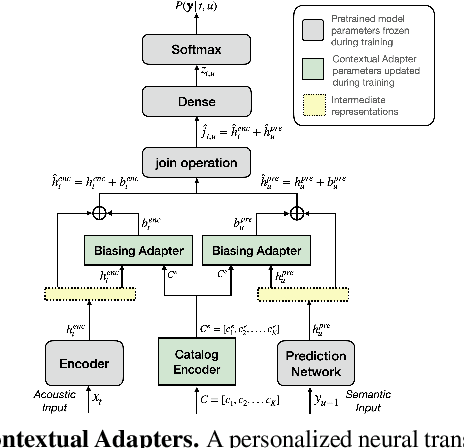

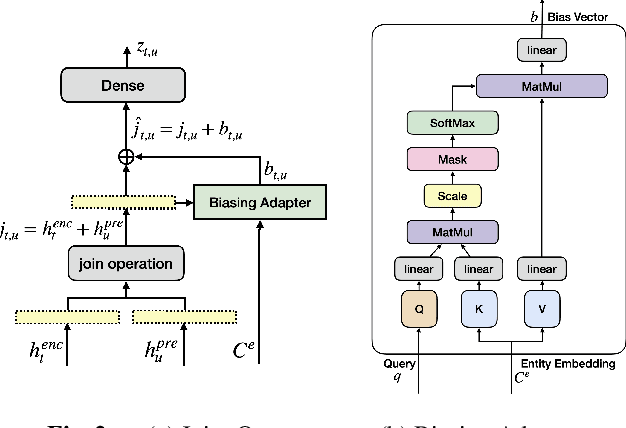
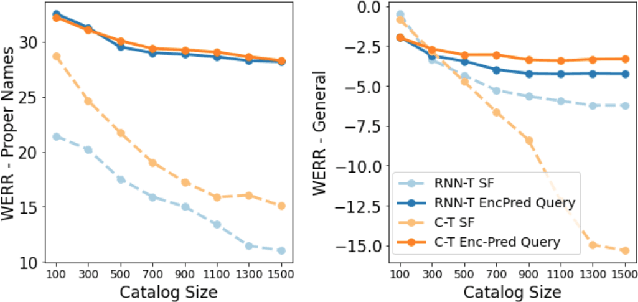
Abstract:Personal rare word recognition in end-to-end Automatic Speech Recognition (E2E ASR) models is a challenge due to the lack of training data. A standard way to address this issue is with shallow fusion methods at inference time. However, due to their dependence on external language models and the deterministic approach to weight boosting, their performance is limited. In this paper, we propose training neural contextual adapters for personalization in neural transducer based ASR models. Our approach can not only bias towards user-defined words, but also has the flexibility to work with pretrained ASR models. Using an in-house dataset, we demonstrate that contextual adapters can be applied to any general purpose pretrained ASR model to improve personalization. Our method outperforms shallow fusion, while retaining functionality of the pretrained models by not altering any of the model weights. We further show that the adapter style training is superior to full-fine-tuning of the ASR models on datasets with user-defined content.
Multi-task RNN-T with Semantic Decoder for Streamable Spoken Language Understanding
Apr 01, 2022
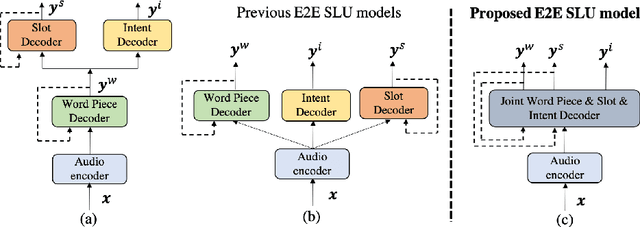

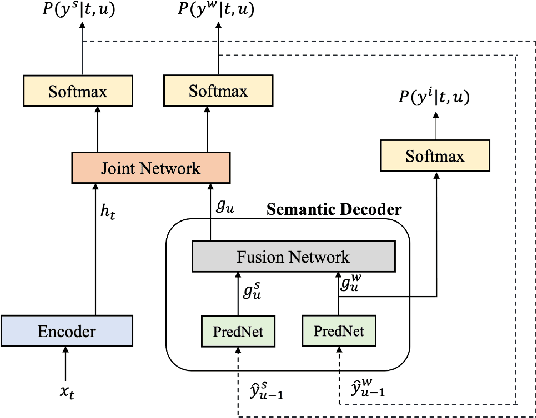
Abstract:End-to-end Spoken Language Understanding (E2E SLU) has attracted increasing interest due to its advantages of joint optimization and low latency when compared to traditionally cascaded pipelines. Existing E2E SLU models usually follow a two-stage configuration where an Automatic Speech Recognition (ASR) network first predicts a transcript which is then passed to a Natural Language Understanding (NLU) module through an interface to infer semantic labels, such as intent and slot tags. This design, however, does not consider the NLU posterior while making transcript predictions, nor correct the NLU prediction error immediately by considering the previously predicted word-pieces. In addition, the NLU model in the two-stage system is not streamable, as it must wait for the audio segments to complete processing, which ultimately impacts the latency of the SLU system. In this work, we propose a streamable multi-task semantic transducer model to address these considerations. Our proposed architecture predicts ASR and NLU labels auto-regressively and uses a semantic decoder to ingest both previously predicted word-pieces and slot tags while aggregating them through a fusion network. Using an industry scale SLU and a public FSC dataset, we show the proposed model outperforms the two-stage E2E SLU model for both ASR and NLU metrics.
Attentive Contextual Carryover for Multi-Turn End-to-End Spoken Language Understanding
Dec 13, 2021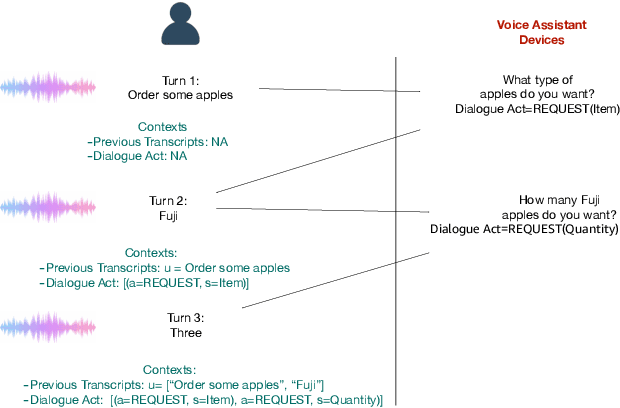
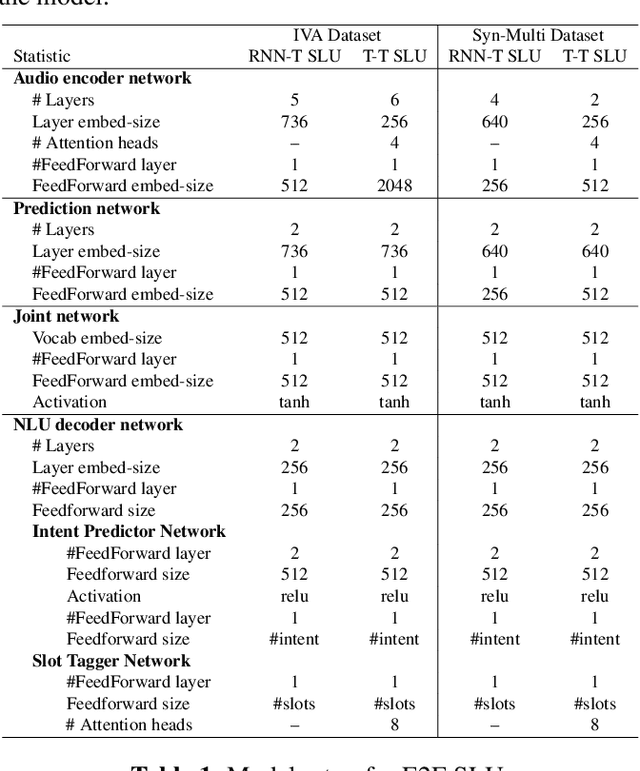
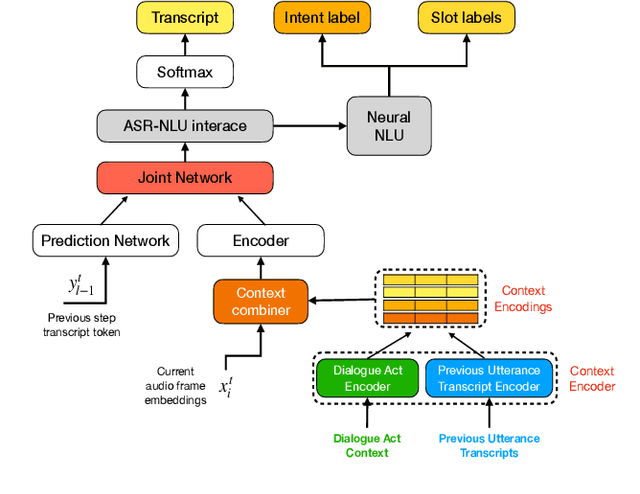
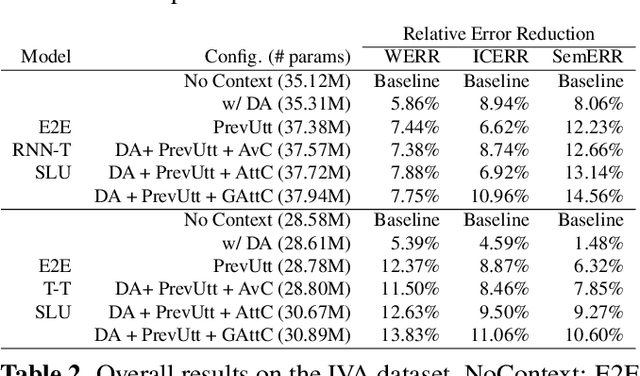
Abstract:Recent years have seen significant advances in end-to-end (E2E) spoken language understanding (SLU) systems, which directly predict intents and slots from spoken audio. While dialogue history has been exploited to improve conventional text-based natural language understanding systems, current E2E SLU approaches have not yet incorporated such critical contextual signals in multi-turn and task-oriented dialogues. In this work, we propose a contextual E2E SLU model architecture that uses a multi-head attention mechanism over encoded previous utterances and dialogue acts (actions taken by the voice assistant) of a multi-turn dialogue. We detail alternative methods to integrate these contexts into the state-ofthe-art recurrent and transformer-based models. When applied to a large de-identified dataset of utterances collected by a voice assistant, our method reduces average word and semantic error rates by 10.8% and 12.6%, respectively. We also present results on a publicly available dataset and show that our method significantly improves performance over a noncontextual baseline
Extreme Model Compression for On-device Natural Language Understanding
Nov 30, 2020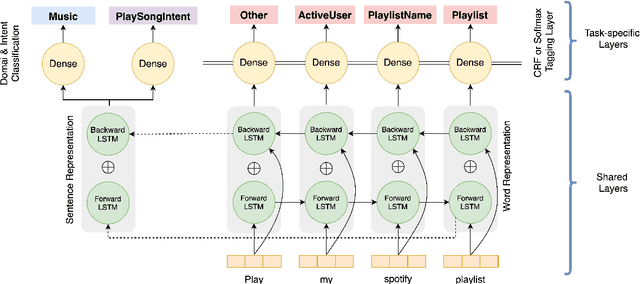
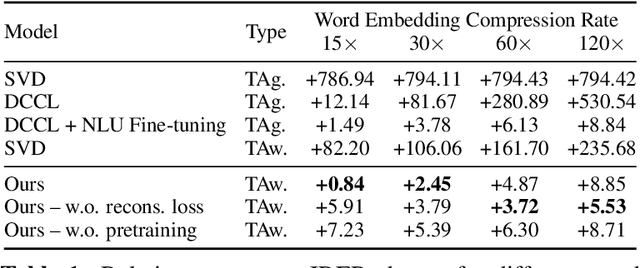
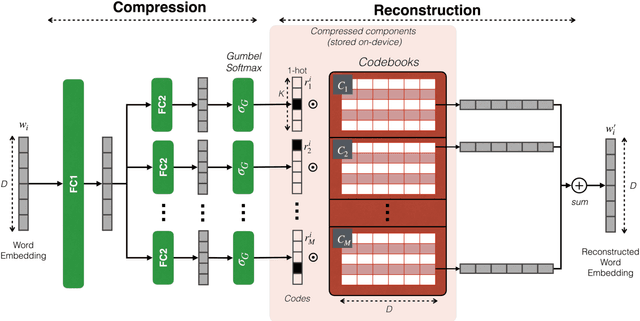
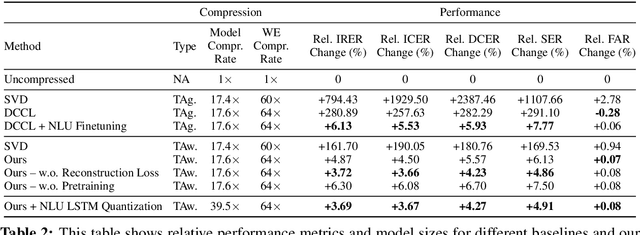
Abstract:In this paper, we propose and experiment with techniques for extreme compression of neural natural language understanding (NLU) models, making them suitable for execution on resource-constrained devices. We propose a task-aware, end-to-end compression approach that performs word-embedding compression jointly with NLU task learning. We show our results on a large-scale, commercial NLU system trained on a varied set of intents with huge vocabulary sizes. Our approach outperforms a range of baselines and achieves a compression rate of 97.4% with less than 3.7% degradation in predictive performance. Our analysis indicates that the signal from the downstream task is important for effective compression with minimal degradation in performance.
Statistical Model Compression for Small-Footprint Natural Language Understanding
Jul 19, 2018


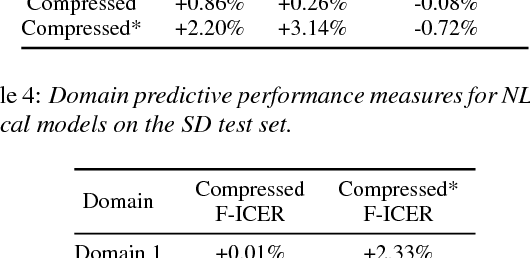
Abstract:In this paper we investigate statistical model compression applied to natural language understanding (NLU) models. Small-footprint NLU models are important for enabling offline systems on hardware restricted devices, and for decreasing on-demand model loading latency in cloud-based systems. To compress NLU models, we present two main techniques, parameter quantization and perfect feature hashing. These techniques are complementary to existing model pruning strategies such as L1 regularization. We performed experiments on a large scale NLU system. The results show that our approach achieves 14-fold reduction in memory usage compared to the original models with minimal predictive performance impact.
Gated-Attention Architectures for Task-Oriented Language Grounding
Jan 09, 2018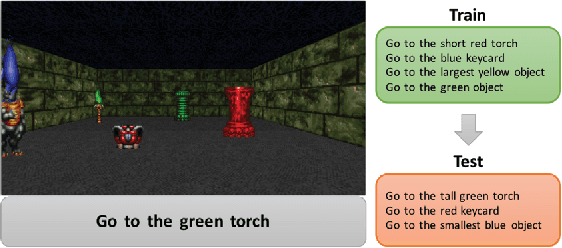


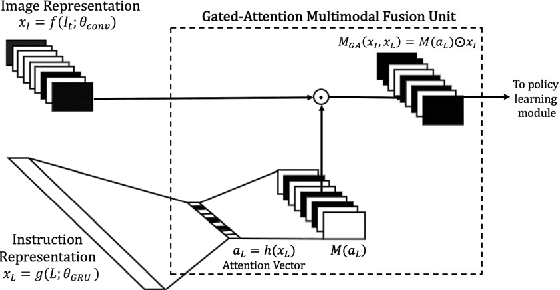
Abstract:To perform tasks specified by natural language instructions, autonomous agents need to extract semantically meaningful representations of language and map it to visual elements and actions in the environment. This problem is called task-oriented language grounding. We propose an end-to-end trainable neural architecture for task-oriented language grounding in 3D environments which assumes no prior linguistic or perceptual knowledge and requires only raw pixels from the environment and the natural language instruction as input. The proposed model combines the image and text representations using a Gated-Attention mechanism and learns a policy to execute the natural language instruction using standard reinforcement and imitation learning methods. We show the effectiveness of the proposed model on unseen instructions as well as unseen maps, both quantitatively and qualitatively. We also introduce a novel environment based on a 3D game engine to simulate the challenges of task-oriented language grounding over a rich set of instructions and environment states.
 Add to Chrome
Add to Chrome Add to Firefox
Add to Firefox Add to Edge
Add to Edge